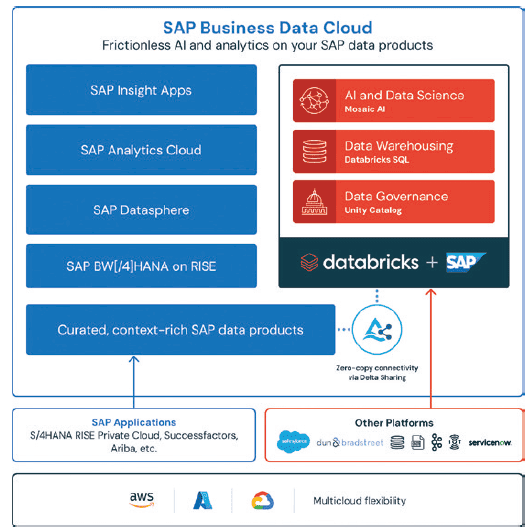What Was That?


"What was that?" Friedrich Merz began his answer. Olaf Scholz had behaved as if he were at a Juso (young socialists) federal congress, Merz said in the last session of the Bundestag before the elections. Scholz and his vice chancellor, Robert Habeck, seemed to him like two managers who had driven a company to the wall and then suggested: "We would like to continue like this for another four years.”
Muhammad Alam, a member of SAP's executive board, was no different when he presented the Business Data Cloud on February 12 during the SAP Unleashed press conference. According to Alam, the new data platform was developed in collaboration with US company Databricks. At the presentation for analysts and journalists, however, no Databricks representative would appear to explain. This leads me to my question: what was that?
A recent blog post may provide an answer to Databricks' surprising reticence: In a graphic (featured below), Databricks illustrates the deepening collaboration, according to SAP. The graphic shows a dual-stack principle as the SAP community knows it from SAP NetWeaver with Abap and Java. The SAP data services are listed in blue and the Databricks solutions next to them in red. These two stacks are connected by the common heading "SAP Business Data Cloud" and at the bottom by an inconspicuous interface called "Zero-copy connectivity via Delta Sharing". SAP and Databricks thus have a common crystallization point and are looking forward to deepening their partnership.

SAP graphic about SAP Business Data Cloud
A few weeks ago, SAP CEO Christian Klein described this announcement as one of the biggest innovations in SAP's history. However, CEO Muhammad Alam could not show much more than a simple interface and the consolidation of SAP's Analytics Cloud, Datasphere and BW services under the new name Business Data Cloud. As Americans would say: where is the beef? Where is the substance?
Since neither questions about licensing, costs, ECC compatibility, on-prem or cloud availability, nor resources on the Databricks side were discussed or answered, this SAP innovation must be disqualified and taken as a non-announcement. That is why the two most important members of SAP's Executive Board, Christian Klein and Thomas Saueressig, were not present at the press and analyst presentation.
Nevertheless, SAP's concerns are unfounded: the announcement was a no-brainer, and Christian Klein and CFO Dominik Asam's storytelling to financial analysts and the stock market is working extremely well.
WiWo author Anton Riedl summed it up in mid-February in "Riedl's Dax Radar" on wiwo.de: "Whether SAP shares can maintain this pace for much longer is questionable in view of the enormous gains. At 46 times this year's expected earnings, the valuation of earnings is quite high—both by SAP standards and in international comparison. [...] The DAX's most important price driver is currently overheated, but that does not mean that it will automatically slide.
SAP is slipping more and more conceptually and strategically. SAP customers’ dissatisfaction is growing, and with the announcement of a new SAP Business Suite and cloud concepts based on the Business Technology Platform, and now the Business Data Cloud, S/4 Hana is increasingly being sidelined. Even an ECC maintenance extension until 2033 will not be able to save it. The Business Suite relaunch sounds like the final act of desperation.





